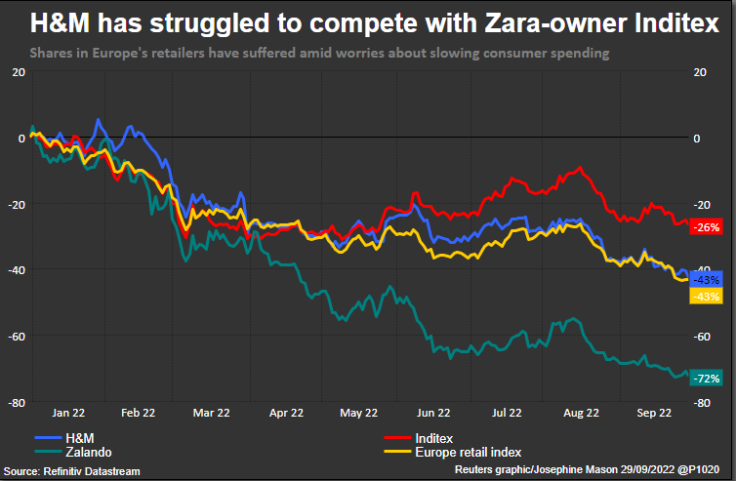H&M To Cut Costs As Profits Hit By Inflation, Cautious Shoppers

H&M, the world's No.2 fashion retailer, launched a 2 billion Swedish crown ($177 million) cost savings drive on Thursday after reporting weaker-than-expected profits due to soaring input costs, slowing consumer spending and its exit from Russia.
In Europe, where H&M does the bulk of its business, the Ukraine conflict, record energy prices and high inflation are weighing on consumer confidence, and households are cutting back on spending as they brace for tougher times.
Pretax profit in the June-August period, the Swedish group's fiscal third quarter, fell to 689 million crowns ($60.9 million) from 6.09 billion a year-earlier. Five analysts polled by Refinitiv had on average forecast a 2.98 billion crown profit.
The company did not give details of where it hoped to make cost savings, but said the benefits should be felt in the second half of 2023.
Its shares were down 3% in mid-morning trading, taking a year-to-date drop to 43%.
H&M said a 2.1 billion crown one-off cost for winding down its business in Russia, announced in July, accounted for only about half of the profit drop.
Earlier this month, the group reported lower-than-expected sales for the period as shoppers reined in spending in the face of soaring energy and other living costs, but said demand had improved late in the quarter.
The retailer said on Thursday a heatwave in many European markets in the summer and delays in the supply chain also weighed on sales.
Meanwhile, increased raw materials and freight prices, and a stronger U.S. dollar, resulted in substantial cost increases for purchases of goods.
"Overall, these factors had a substantial negative impact on profit for the quarter," CEO Helena Helmersson said. "We have chosen not to fully compensate for the increased costs, which is reflected in the gross margin."
Graphic: H&M vs rivals-

SEPTEMBER DEMAND PICKUP
"We note significant margin headwinds to come, particularly given the stronger USD relative to EUR, as well as higher energy costs and a loss of high margin Russian business," Royal Bank of Canada analyst Richard Chamberlain said in a note to clients.
Market leader Inditex, the owner of Zara, which has been weathering the tough market conditions better than H&M, increased sales in its May-July quarter. The Spanish group's growth, however, slowed in the Aug.1-Sept. 11 period.
H&M said its autumn collections had been well received, with sales up 7% year-on-year in local currencies from Sept. 1-27 - the start of its fiscal fourth quarter, against a 4% drop in the third quarter.
Helmersson told analysts markets that had been weak in the quarter, such as central Europe, had picked up in September.
Analysts at Credit Suisse said: "Despite modest expectations, profitability in 3Q was significantly worse than expected and the outlook for margins over the next year continues to deteriorate," they said, adding that they expect demand to soften in the rest of the year from the first half as inflationary pressures squeeze shoppers.
($1 = 11.3104 Swedish crowns)
© Copyright Thomson Reuters {{Year}}. All rights reserved.





















